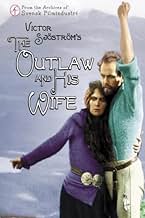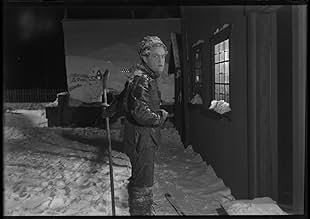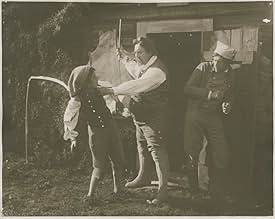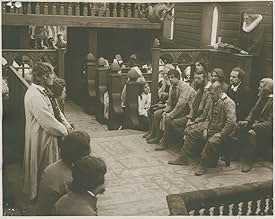IMDb RATING
7.2/10
2.2K
YOUR RATING
Ejvind and his family are in need of food. So Ejvind seeks help from the rich priest next door. He refuses to help. Ejvind then steals a sheep from the priest, he is caught. But he escapes f... Read allEjvind and his family are in need of food. So Ejvind seeks help from the rich priest next door. He refuses to help. Ejvind then steals a sheep from the priest, he is caught. But he escapes from prison, and becomes an outlaw.Ejvind and his family are in need of food. So Ejvind seeks help from the rich priest next door. He refuses to help. Ejvind then steals a sheep from the priest, he is caught. But he escapes from prison, and becomes an outlaw.
- Director
- Writers
- Stars
Walerie Alexandrow-Höök
- Berg-Ejvinds och Hallas dotter Tota
- (as Walerie Alexandrow)
- Director
- Writers
- All cast & crew
- Production, box office & more at IMDbPro
Featured reviews
Berg-Ejvind Och Hans Hustru / The Outlaw and His Wife (1918) :
Brief Review -
A tragic love story of an Icelandic outlaw with a groundbreaking filming process. The first thing you should know about The Outlaw and His Wife is that it's a groundbreaking film when it comes to cinematography and the shooting process. It was groundbreaking for its portrayal of wild nature, as it was shot in two sessions in the spring and late summer. We modern audiences and critics talk about Richard Linklater's "Boyhood" (2014) for its long filming process that took 12 years or something, but how many of us ever discuss old treasures like this? We should, and I am doing my part today. Victor Sjöström's silent romantic tragedy has everything that makes for a good watch. The storyline is exactly what any romantic melodrama will have. It has emotion and that love factor working as the USPs throughout the narrative. At one point, I thought it was trying to be philosophical, but then everything went as planned, and believe me, I was hoping it would behave like a film made 104 years ago. A stranger comes to work at widow Halla's farm. She falls in love and he shares her feelings, but their happiness is cut short by God or destiny, whatever you call it, as his haunting past strikes with new challenges. Halla learns about Eyvind's past and yet decides to follow him for life. What challenges she had to face in the marriage and how they both tackled them is all that you get to see in The Outlaw and His Wife. Victor Sjöström's film seems like an extremely expressionist film, as Victor Sjöström and Edith Erastoff both give such exorbitant expressions. Also, we can't forget the fact that the cinema of 1918 was like this, even if it was changing rapidly in the West. Nevertheless, the greatest Swedish director of its time makes sure that your time is worth spending on something. Love story and love tragedy lovers should definitely see this to know the true meaning of love.
RATING - 7/10*
By - #samthebestest.
A tragic love story of an Icelandic outlaw with a groundbreaking filming process. The first thing you should know about The Outlaw and His Wife is that it's a groundbreaking film when it comes to cinematography and the shooting process. It was groundbreaking for its portrayal of wild nature, as it was shot in two sessions in the spring and late summer. We modern audiences and critics talk about Richard Linklater's "Boyhood" (2014) for its long filming process that took 12 years or something, but how many of us ever discuss old treasures like this? We should, and I am doing my part today. Victor Sjöström's silent romantic tragedy has everything that makes for a good watch. The storyline is exactly what any romantic melodrama will have. It has emotion and that love factor working as the USPs throughout the narrative. At one point, I thought it was trying to be philosophical, but then everything went as planned, and believe me, I was hoping it would behave like a film made 104 years ago. A stranger comes to work at widow Halla's farm. She falls in love and he shares her feelings, but their happiness is cut short by God or destiny, whatever you call it, as his haunting past strikes with new challenges. Halla learns about Eyvind's past and yet decides to follow him for life. What challenges she had to face in the marriage and how they both tackled them is all that you get to see in The Outlaw and His Wife. Victor Sjöström's film seems like an extremely expressionist film, as Victor Sjöström and Edith Erastoff both give such exorbitant expressions. Also, we can't forget the fact that the cinema of 1918 was like this, even if it was changing rapidly in the West. Nevertheless, the greatest Swedish director of its time makes sure that your time is worth spending on something. Love story and love tragedy lovers should definitely see this to know the true meaning of love.
RATING - 7/10*
By - #samthebestest.
On my continued journey through silent film from the early 20th century, this is my favorrite one yet. I found the changing colors much less distracting, and at points even felt like the colors added to the tone of the scene. I particularly enjoyed the costumes in this film, and found the plot much easier to follow than other films of this category. I enjoyed seeing a strong female character, unlike in 'A Man There Was'. There are both laughs and cries throughout this film, and the ending I thought was beautiful. The title cards consisted of more dialogue than I'd seen in previous films, which helped to make the plot more understandable.
I have waited for years to see this film and finally caught it on Youtube - in excellent condition. It was definitely worth the wait! The film was made in 1918, a time when most cinema consisted of small segments of celluloid patched together with the standard melodramatic or comedic situations, clumsily filmed indoors on make-shift sets. This is absolutely nothing of the kind although it took Hollywood what seemed an eternity to figure out that a movie could, indeed, be shot out in the open with great success. Several reviewers have mentioned some sort of connection with early Westerns made by directors of little artistic talent and less scope. Actually, this film has nothing whatsoever to deal with standard plots with famous actors. The plot is extremely simple, as it should be in this case, and all - virtually all - of the over-the-board overacting and the theatrical motions and over-emotions suppressed, with natural gestures replacing them in natural settings...and what beautiful settings they are! No, there aren't any tied-together happy ends around and little to titillate the audience, villains with mustaches or any of the standard American clichés here. The film is Scandinavian, filmed and acted by Scandinavians, shot in North Sweden far, far away from the ole corral. I don't know how well the director, Victor Sjostrom, was acquainted with American cinema at the time - there wasn't really much of anything of much value going except from Griffith and one or two others, but the film borrows nothing and invents everything for its own uses. The cinema up there created a universe of its own, albeit a harsh one. Bergman would follow fifty years later. This was a welcome hour or so spent in the company of people who made some astoundingly good films and this is certainly one of them.
Curtis Stotlar
Curtis Stotlar
The stunning Lappland scenery and seeing Victor Sjöström made this one enjoyable for me, despite a little creakiness in the early going. The setup, actually told in a flashback, reminded me of Les Miserables in that a man (Sjöström) turns to theft out of poverty, but instead of the local parson forgiving him as in that work, he jails him instead. Perhaps there is commentary on the church in this, and the need to show a little kindness to the less fortunate, since everything that happens to this decent guy stems from that incident. Anyway, he breaks out of jail, finds work on a farm, and falls in love with the owner (Edith Erastoff), but his past is never far behind.
The film gets good and the drama increases when the pair flee to the mountains, where they live a rugged life and have a baby girl. There are several moments at a cliff that are quite tense, and one that seems hard to fathom (I mean, really hard to fathom). Maybe the film shows us what desperation will drive people to, aside from the theft - jealousy, turning on one another, and acts you'd never think possible. Set against the grand scenery of those timeless mountains and waterfalls though, the human struggle seems especially small, even when it is gripping.
The pace is quite good at 73 minutes - intertitles are kept to a minimum, and the story, while simple, moves along nicely. At times it feels like the psychological drama is as claustrophobic as the wilderness is wide open. The film is obviously a bit stiff to modern eyes, but it seems clear that for 1918, it was ahead of its time.
The film gets good and the drama increases when the pair flee to the mountains, where they live a rugged life and have a baby girl. There are several moments at a cliff that are quite tense, and one that seems hard to fathom (I mean, really hard to fathom). Maybe the film shows us what desperation will drive people to, aside from the theft - jealousy, turning on one another, and acts you'd never think possible. Set against the grand scenery of those timeless mountains and waterfalls though, the human struggle seems especially small, even when it is gripping.
The pace is quite good at 73 minutes - intertitles are kept to a minimum, and the story, while simple, moves along nicely. At times it feels like the psychological drama is as claustrophobic as the wilderness is wide open. The film is obviously a bit stiff to modern eyes, but it seems clear that for 1918, it was ahead of its time.
It's hard to imagine, but only a few years before this film debuted, most films were only a few minutes long. And, full-length films really were a pretty new thing. So, to see a long, complex and cinematic film like "You and I" shows just how far the industry had grown. Victor Sjöström plays a man who is on the run from the law. Years earlier, he'd been sent to prison for stealing a sheep to feed his family and he'd eventually broken out of a tiny make-shift prison in Iceland. The film picks up when he's on the run in the interior of the country--looking for work and hoping no one recognizes him. In the process, a woman takes him in to work on her farm and eventually the two fall in love....at about the time the law shows up to claim him. The two run off together and live in the inhospitable wilds for the next 17 years (yikes). Exactly what happens is something you'll just need to see for yourself--but it does have some nice surprises.
The film is well worth seeing mostly for the nice acting and cinematography. Interestingly, in addition to starring in the film, Sjöström directed and co-wrote this film--and the look of the film can clearly be attributed to him. I also appreciate how he was able to recreate the look of Iceland nicely by apparently filming in the middle of no where AND in pretty inhospitable weather. A very good film--and it has some nice things to say about crime and punishment.
The film is well worth seeing mostly for the nice acting and cinematography. Interestingly, in addition to starring in the film, Sjöström directed and co-wrote this film--and the look of the film can clearly be attributed to him. I also appreciate how he was able to recreate the look of Iceland nicely by apparently filming in the middle of no where AND in pretty inhospitable weather. A very good film--and it has some nice things to say about crime and punishment.
Did you know
- TriviaBased on the story of Eyvindur of the Mountains (1714-1783), an outlaw in Iceland who fled into the mountains with his wife around 1760 and remained there for twenty years.
- Alternate versionsTurner Classic Movies has shown on TV a restored version copyrighted in 1968 by Svenska Filminstitutet (The Swedish Film Instute). The restoration credits are in Swedish, but some of the original cast and crew credits are in English. All intertitles are in English and the film runs 73 minutes.
- ConnectionsFeatured in Victor Sjöström - ett porträtt av Gösta Werner (1981)
- SoundtracksKung Kristian II, op. 27
Composed by Jean Sibelius (1898)
- How long is The Outlaw and His Wife?Powered by Alexa
Details
- Release date
- Country of origin
- Official site
- Language
- Also known as
- The Outlaw and His Wife
- Filming locations
- Nuolja, Abisko, Sweden(mountain scenery)
- Production company
- See more company credits at IMDbPro
Box office
- Budget
- SEK 100,000 (estimated)
- Runtime1 hour 12 minutes
- Sound mix
- Aspect ratio
- 1.33 : 1
Contribute to this page
Suggest an edit or add missing content































